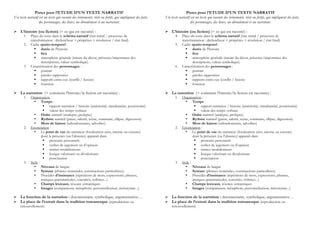Signaler
Partager
Télécharger pour lire hors ligne

Recommandé
Recommandé
More than Just Lines on a Map: Best Practices for U.S Bike Routes
This session highlights best practices and lessons learned for U.S. Bike Route System designation, as well as how and why these routes should be integrated into bicycle planning at the local and regional level.
Presenters:
Presenter: Kevin Luecke Toole Design Group
Co-Presenter: Virginia Sullivan Adventure Cycling AssociationMore than Just Lines on a Map: Best Practices for U.S Bike Routes

More than Just Lines on a Map: Best Practices for U.S Bike RoutesProject for Public Spaces & National Center for Biking and Walking
Contenu connexe
En vedette
More than Just Lines on a Map: Best Practices for U.S Bike Routes
This session highlights best practices and lessons learned for U.S. Bike Route System designation, as well as how and why these routes should be integrated into bicycle planning at the local and regional level.
Presenters:
Presenter: Kevin Luecke Toole Design Group
Co-Presenter: Virginia Sullivan Adventure Cycling AssociationMore than Just Lines on a Map: Best Practices for U.S Bike Routes

More than Just Lines on a Map: Best Practices for U.S Bike RoutesProject for Public Spaces & National Center for Biking and Walking
En vedette (20)
How to Prepare For a Successful Job Search for 2024

How to Prepare For a Successful Job Search for 2024
Social Media Marketing Trends 2024 // The Global Indie Insights

Social Media Marketing Trends 2024 // The Global Indie Insights
Trends In Paid Search: Navigating The Digital Landscape In 2024

Trends In Paid Search: Navigating The Digital Landscape In 2024
5 Public speaking tips from TED - Visualized summary

5 Public speaking tips from TED - Visualized summary
Google's Just Not That Into You: Understanding Core Updates & Search Intent

Google's Just Not That Into You: Understanding Core Updates & Search Intent
The six step guide to practical project management

The six step guide to practical project management
Beginners Guide to TikTok for Search - Rachel Pearson - We are Tilt __ Bright...

Beginners Guide to TikTok for Search - Rachel Pearson - We are Tilt __ Bright...
Unlocking the Power of ChatGPT and AI in Testing - A Real-World Look, present...

Unlocking the Power of ChatGPT and AI in Testing - A Real-World Look, present...
More than Just Lines on a Map: Best Practices for U.S Bike Routes

More than Just Lines on a Map: Best Practices for U.S Bike Routes
Ride the Storm: Navigating Through Unstable Periods / Katerina Rudko (Belka G...

Ride the Storm: Navigating Through Unstable Periods / Katerina Rudko (Belka G...
Good Stuff Happens in 1:1 Meetings: Why you need them and how to do them well

Good Stuff Happens in 1:1 Meetings: Why you need them and how to do them well
Analyserletexte narratif
- 1. Pistes pour l’ETUDE D’UN TEXTE NARRATIF Un texte narratif est un texte qui raconte des événements, réels ou fictifs, qui impliquent des faits, des personnages, des lieux, un déroulement et un narrateur. L’histoire (ou fiction) (= ce qui est raconté) : 1. Place du texte dans le schéma narratif (état initial / processus de transformation : déclencheur + péripéties + résolution / état final) 2. Cadre spatio-temporel : durée de l'histoire lieu atmosphère générale (nature du décor, présence/importance des descriptions, valeur symbolique) 3. Caractérisation des personnages : portrait paroles rapportées rapports entre eux (conflit / fusion) fonction La narration (= comment l’histoire/la fiction est racontée) : 1. Organisation : • Temps : rapport narration / histoire (antériorité, simultanéité, postériorité) valeur des temps verbaux • Ordre narratif (analepse, prolepse) • Rythme narratif (pause, ralenti, scène, sommaire, ellipse, digression) • Mots de liaison (subordonnants, adverbes) 2. Enonciation : • Le point de vue du narrateur (focalisation zéro, interne ou externe) dont la présence (ou l’absence) apparaît dans pronoms personnels verbes de jugement ou d’opinion termes modalisateurs lexique valorisant ou dévalorisant ponctuation 3. Style : • Niveaux de langue • Syntaxe (phrases nominales, constructions particulières) • Procédés d’insistance (répétitions de mots, expressions, phrases, marques grammaticales, sonorités, rythmes...) • Champs lexicaux, réseaux sémantiques • Images (comparaison, métaphore, personnification, métonymie...) La fonction de la narration : documentaire, symbolique, argumentative… La place de l’extrait dans la tradition romanesque (reproduction ou renouvellement) Pistes pour l’ETUDE D’UN TEXTE NARRATIF Un texte narratif est un texte qui raconte des événements, réels ou fictifs, qui impliquent des faits, des personnages, des lieux, un déroulement et un narrateur. L’histoire (ou fiction) (= ce qui est raconté) : 4. Place du texte dans le schéma narratif (état initial / processus de transformation : déclencheur + péripéties + résolution / état final) 5. Cadre spatio-temporel : durée de l'histoire lieu atmosphère générale (nature du décor, présence/importance des descriptions, valeur symbolique) 6. Caractérisation des personnages : portrait paroles rapportées rapports entre eux (conflit / fusion) fonction La narration (= comment l’histoire/la fiction est racontée) : 1. Organisation : • Temps : rapport narration / histoire (antériorité, simultanéité, postériorité) valeur des temps verbaux • Ordre narratif (analepse, prolepse) • Rythme narratif (pause, ralenti, scène, sommaire, ellipse, digression) • Mots de liaison (subordonnants, adverbes) 2. Enonciation : • Le point de vue du narrateur (focalisation zéro, interne ou externe) dont la présence (ou l’absence) apparaît dans pronoms personnels verbes de jugement ou d’opinion termes modalisateurs lexique valorisant ou dévalorisant ponctuation 3. Style : • Niveaux de langue • Syntaxe (phrases nominales, constructions particulières) • Procédés d’insistance (répétitions de mots, expressions, phrases, marques grammaticales, sonorités, rythmes...) • Champs lexicaux, réseaux sémantiques • Images (comparaison, métaphore, personnification, métonymie...) La fonction de la narration : documentaire, symbolique, argumentative… La place de l’extrait dans la tradition romanesque (reproduction ou renouvellement)
